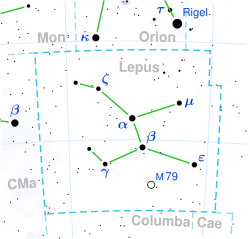うさぎ座イータ星
うさぎ座の恒星
うさぎ座η星(うさぎざイータせい、η Leporis、η Lep)は、うさぎ座の恒星である。見かけの等級は3.71と、肉眼でみることができる明るさである[1]。ヒッパルコス衛星が測定した年周視差を基に太陽からの距離を計算すると、約49光年となる[2]。
| うさぎ座η星 η Leporis | ||
|---|---|---|
| 星座 | うさぎ座 | |
| 見かけの等級 (mv) | 3.71[1] | |
| 位置 元期:J2000.0 | ||
| 赤経 (RA, α) | 05h 56m 24.2930042s[2] | |
| 赤緯 (Dec, δ) | −14° 10′ 03.718884″[2] | |
| 視線速度 (Rv) | -2.14 ± 0.27 km/s[2] | |
| 固有運動 (μ) | 赤経: -42.06 ミリ秒/年[2] 赤緯: 139.26 ミリ秒/年[2] | |
| 年周視差 (π) | 67.21 ± 0.25ミリ秒[2] (誤差0.4%) | |
| 距離 | 48.5 ± 0.2 光年[注 1] (14.88 ± 0.06 パーセク[注 1]) | |
| 絶対等級 (MV) | 2.85 | |
うさぎ座η星の位置(丸印)
| ||
| 物理的性質 | ||
| 半径 | 1.56 M☉[3] | |
| 質量 | 1.42 M☉[4] | |
| 表面重力 | 7 G[5][注 2] | |
| 自転速度 | 13.5 km/s[5] | |
| スペクトル分類 | F1 V[1] | |
| 光度 | 5 L☉[注 3] | |
| 表面温度 | 6,925 K[5] | |
| 色指数 (B-V) | 0.337[1] | |
| 色指数 (V-I) | 0.39[1] | |
| 金属量[Fe/H] | -0.17[5] | |
| 年齢 | 1.80 +0.34 −0.55 ×109 年[4] | |
| 他のカタログでの名称 | ||
| うさぎ座16番星, BD-14 1286, FK5 226, GJ 225, HD 40136, HIP 28103, HR 2085, SAO 150957[2] | ||
| ■Template (■ノート ■解説) ■Project | ||
特徴
編集| 太陽 | うさぎ座η星 |
|---|---|
うさぎ座η星はF型主系列星で、スペクトル型はF1 Vに分類される[1]。年齢はおよそ18億年で、自転速度は13.5km/s以上とみられる[4][5]。質量は太陽の1.4倍、半径は太陽の1.6倍程度、表面温度は約6,900Kと推定される[4][3]。
うさぎ座η星からは、スピッツァー宇宙望遠鏡による観測で、波長32μm、70μmの遠赤外線で赤外超過が検出されており、恒星の周りには暖かい塵の星周円盤があると考えられる。単純な塵の模型で考えると、円盤はうさぎ座&deta;星を中心に1 auから16 auに広がり、塵の温度は星に近い領域で353K、星から遠い領域で92Kと予想される。円盤の外側は、うさぎ座η星の凍結線よりも外であり、水の氷の粒子がかなり含まれるとみられる[6]。
脚注
編集注釈
編集- ^ a b パーセクは1 ÷ 年周視差(秒)より計算、光年は1÷年周視差(秒)×3.2615638より計算
- ^ 出典での表記は、
- ^ シュテファン=ボルツマンの法則により計算
出典
編集- ^ a b c d e f ESA (1997), The HIPPARCOS and TYCHO catalogues. Astrometric and photometric star catalogues derived from the ESA HIPPARCOS Space Astrometry Mission, ESA SP Series, 1200, Noordwijk, Netherlands: ESA Publications Division, Bibcode: 1997ESASP1200.....E, ISBN 9290923997
- ^ a b c d e f g h “eta Lep -- High proper-motion Star”. SIMBAD. CDS. 2021年1月30日閲覧。
- ^ a b Wood, Brian E.; et al. (2018-07), “A Chandra/LETGS Survey of Main-sequence Stars”, Astrophysical Journal 862 (1): 66, Bibcode: 2018ApJ...862...66W, doi:10.3847/1538-4357/aaccf6
- ^ a b c d Casagrande, L.; et al. (2011-06), “New constraints on the chemical evolution of the solar neighbourhood and Galactic disc(s). Improved astrophysical parameters for the Geneva-Copenhagen Survey”, Astronomy & Astrophysics 530: A138, Bibcode: 2011A&A...530A.138C, doi:10.1051/0004-6361/201016276
- ^ a b c d e Yüce, Kutluay; Adelman, Saul J. (2014-04), “Elemental Abundance Analyses with DAO Spectrograms. XXXIV. A Three-Dimensional Graphical Examination of the Elemental Abundances of the Mercury-Manganese and Metallic-Line Stars”, Publications of the Astronomical Society of the Pacific 126 (938): 345-358, Bibcode: 2014PASP..126..345Y, doi:10.1086/676335
- ^ Lawler, S. M.; et al. (2009-11), “Explorations Beyond the Snow Line: Spitzer/IRS Spectra of Debris Disks Around Solar-type Stars”, Astrophysical Journal 705 (1): 89-111, Bibcode: 2009ApJ...705...89L, doi:10.1088/0004-637X/705/1/89
